The Swing - 1
Generating and maximizing swing has application in a wide variety of activities and sports. From a gymnastics perspective, swing generally means swinging your body on an apparatus, but the principles and techniques apply to swinging objects with your body as well.
There are four fundamental factors involved with maximizing swing: maximizing momentum in the downward phase, maintaining momentum throughout the swing, maximizing the application of force against gravity in the upward phase, and minimizing loss of speed in the upward phase. All four factors are affected dramatically by body mechanics. Proper mechanics can make an enormous swing effortless, and improper mechanics will reduce a potential swing to a wiggle.
Maximizing momentum in the downward phase of the swing involves keeping your center of mass as far as possible from your anchor point (your hands). Moving your center of gravity an inch or two away from the anchor point can have an enormous impact on the outcome of the swing. Maintaining momentum throughout the swing is all about proper mechanics. This is where "staying tight" is critical. It is far easier to swing a stick 360 degrees from vertical to vertical than it is to do the same with a rope. With a rope a lot of momentum will be lost in oscillations in the rope; this loss is not experienced in the stick. Movement in the body being swung should occur only if it generates force in the direction of the swing, moves the center of mass away from the anchor point during the downward phase of the swing, or moves the center of mass closer to the anchor point during the upward phase.
Maximizing the application of force against gravity on the upward phase of the swing can take many forms. It could mean a well timed "tap", or kick against gravity. It could mean shifting the center of gravity off the centripetal line of force which results in a pumping of the swing. It could mean proper positioning so you can push the swing upward. In the case of two or more anchor points (as with support swings on parallel bars) it can also mean proper application of a push in the direction of the swing.
Minimizing the loss of speed in the upward phase of the swing often involves shortening the radius of rotation. Bringing your center of gravity closer to the anchor point will increase the speed of rotation, assuming no external forces are involved.
A brief note on hand care: As you begin swinging you will find that your hands will not be able to handle the abuse. To minimize friction, try not to squeeze the object you are hanging on. Instead, just hook over the object with your fingers. Keeping your hand hooked rather than gripping tightly will greatly reduce the friction on the bar and allow you to practice longer without ripping.
Tap swing
The most common swing is from a single fixed bar. The most effective mechanism for this swing is called a tap swing. During the downward phase of the forward swing your body should be kept hollow and extended. Push away from the bar and ensure that your shoulders are active and pressed up into your ears. As the swing passes through vertical you should allow a small arch with the primary extension being in your chest and shoulders. After the swing passes vertical, kick your toes toward the ceiling-not forward, but up, toward the ceiling. After the kick, pull back on the bar to fully extend your shoulders for the return swing.
The Tap Swing
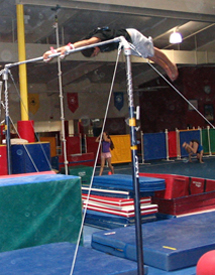
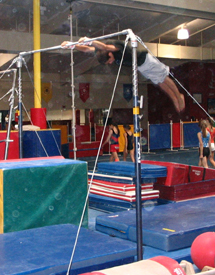
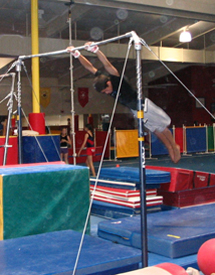
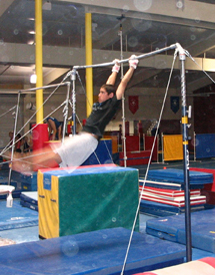
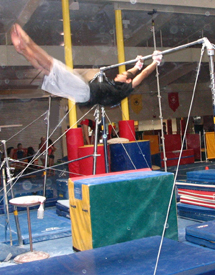
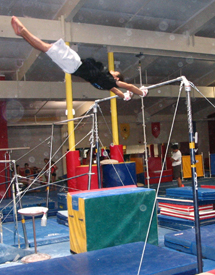
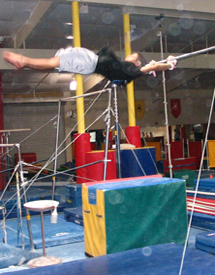
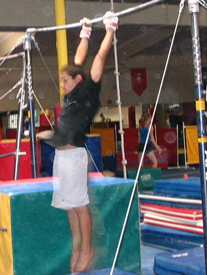
The rearward swing will be essentially a reverse of the forward swing. On the downward swing, the shoulders should be fully extended and the body slightly arched. As the swing passes vertical, the body will hollow slightly, followed by a heel tap. After the heel tap, push down on the bar and hollow as the swing rises, then push against the bar to extend and prepare for the downward swing.
To get started, initiate the swing by lifting your legs upward and forward. Once you have a small swing going, start to work on the tap swing. Initially just try to relax and feel the timing of the swing. Then, as your feel for the timing improves, you can begin to put more into the swing.
As your swing grows you will find it increasingly difficult to hang onto the bar at the end of the rearward swing. Your hands can slide around the bar only when your fingers are following away from the swing; therefore, you must shift your grip at the end of every rearward swing. At the high point of the rearward swing there is a moment of weightlessness. This is the point when you should regrasp the bar and prepare for your next swing. In the extreme this opening of the hands in the rearward swing can become a "peel", an involuntary release of the bar that most gymnasts have experienced at one time or another. Peeling can be avoided with proper hand placements and gripping technique. Once your swings exceed horizontal you will need to overgrip the bar at the end of the forward swing. As you swing, allow your wrists to flex instead of allowing your hands to slide around the bar. Focus on keeping your fingers on top of the bar to avoid peeling. Gymnastics grips will help tremendously if you find it increasingly difficult to hang onto the bar. With grips it is possible to swing nearly to handstand in the forward swing without peeling in the rearward swing.
The mechanics involved in the tap swing are primarily about timing. Once you've got the timing and mechanics down, you can generate a very large swing can be generated with very little effort. The tap swing eventually becomes a giant, which is a swing from handstand to handstand on a high bar, completely around the bar in either direction.
Support swing
A support swing is swinging in a free support between two fixed objects. From this position a swing can approach vertical in the forward swing and reach a handstand in the rearward swing. Working support swings builds support stability, strength, and shoulder mobility.
The Support swing
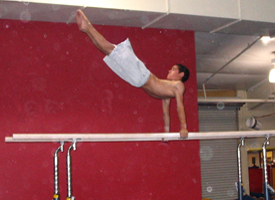
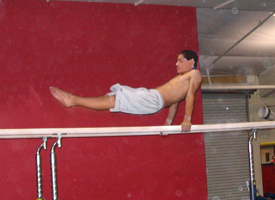
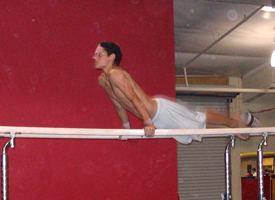
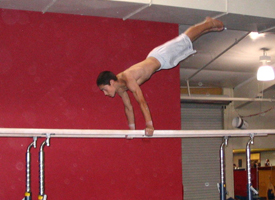
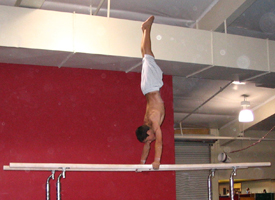
Start practicing the swing focusing on keeping your body completely straight. Your body should maintain a straight line from your shoulders to your toes. Do not pike in the forward swing, and do not arch in the rearward swing. The goal is not to see how high your feet can go, but to swing your entire body efficiently and effectively, as a unit.
In the support your elbows should be turned so that the inside of your elbows are facing forward. This dramatically increases stability and will help prevent buckling as you swing through the bottom.
Once both your forward and rearward swings approach horizontal, you should start practicing the shrug. Through the bottom of the swing shrug your shoulders; then extend them at the top of both forward and rearward swings. This shrug allows for a very dynamic push at the peak of each swing, adding significant power to the movement. Practice the shrug by performing swings with relaxed, shrugged shoulders through the arc of the swing, and then, as it reaches its peak, extend your shoulders. This shrug and push gives additional upward force to the swing enabling greater function.
If you are performing your support swings on parallel bars there is an important skill to learn before attempting to reach a handstand. You should be comfortable with a forward roll on the bars. A forward roll is the safest way to bail out of a handstand that falls forward. Practice forward rolls by first kneeling on the bars. Your knees will be slightly outside the bars and your feet on the inside. Place your hands as close to your knees as possible. Lean forward and lift your hips, stick your elbows out so your upper arms rest on the bars. Push off your legs and roll over your arms, constantly pressing your elbows toward the floor to lock the shoulders into a "shelf" to support you. You will need to let go of the bars as you roll over, but this is a very natural reaction. At the end of the roll you will be in an upper arm support on the bars. Yes, this is uncomfortable, but it's a necessary skill. The discomfort decreases as you get more proficient with the movement.
As the rearward swing approaches handstand, be sure to maintain a hollow body and push with your shoulders. Done properly this will ensure that the swing stops in the handstand. An arched swing leading with the heels, with the head out can easily swing past the handstand requiring a forward roll or other method of bailing out. A proper hollow swing to handstand will settle in the handstand regardless of how much momentum is behind it. If anything the swing will hop as it reaches vertical as the momentum is upward and not forward. A swing to handstand should be just an extension of a normal support swing. If you have to change your body alignment to get to the handstand, then the mechanics of your swing are not correct and you should continue to practice a proper swing before attempting to swing to handstand.
Ring swing
A correct and effective swing on rings takes significantly longer to learn than an effective swing on a bar. A swing on rings is a double pendulum, a very complex system that demands very good timing and body alignment. Proper body tension and maintaining pressure on the rings is critical.
The Ring Swing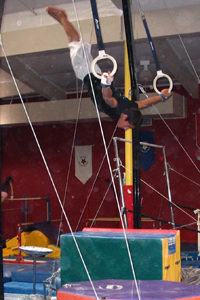
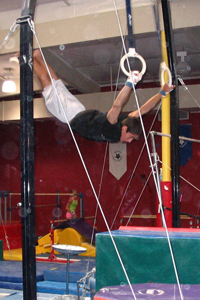
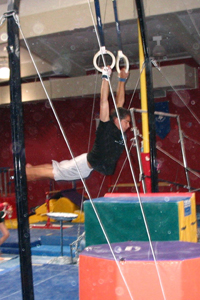
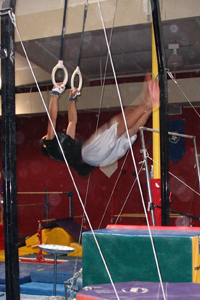
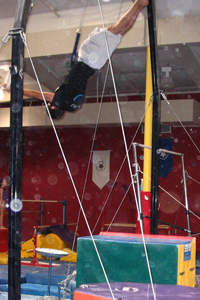
From a hang position on the rings, initiate the swing by kicking your feet forward and backward. Hang relaxed in the shoulders so you can begin to feel the natural period of the swing. As the timing becomes apparent you can begin to drive the swing more aggressively. Consciously squeeze your heels together, particularly in the rearward swing.
From the horizontal position in the front, your shoulders should be pushed back and your body extended as much as possible without arching. If your rearward swing is arched when you reach the bottom there will be a significant downward jerk. This jerk is not only uncomfortable but also decreases momentum and severely limits your swing. Maintain a slight hollow until the rearward swing passes through the bottom. At this point an aggressively kick your heels toward the ceiling (that is, direct the kick up and back, not just back). As the swing rises to the back, keep your chest pressed downward and shoulders open and slightly out to the sides. Maintain pressure on the rings throughout. The rings should also be turned out (pronated, or thumbs inward). This turnout allows a greater range of motion in the shoulders and will allow you to put downward pressure on the rings earlier in the swing than if your hands were not turned out. As the swing peaks, the rings should be brought together and pushed as far forward as possible to prepare for the forward swing.
The beginning of the forward phase of the swing is a reversal of the beginning of the rearward swing. From the face-down horizontal position at the back of the swing, arch your body lightly, press the rings forward as much as possible and push your chest down and slightly forward. Maintain this position until the swing passes through the bottom. As the swing reaches vertical it should turn over rapidly as you drive your toes toward the ceiling. Be sure to turn over by kicking your feet and maintaining a tight body. This turnover must be driven by the kick and not by pulling the rings forward. The rings should be pressed back as the swing turns over. After the turnover, drive your toes toward the ceiling and press the rings back (away from the top of your head) aggressively. At this point the swing should be traveling nearly vertical, and you should be aggressively pressing the rings back and slightly outward. This pressure will drive the swing upward. Do not bend your arms; this pressure is a push, not a pull. As your swing reaches horizontal in the forward swing, the rings will need to be turned in (supinated, or thumbs out) to enable you to push down on the rings as the swing rises above the rings. After the swing peaks in the front, extend away from the rings as much as possible to prepare for the rearward swing.
Mastering these three basic swings can take a significant amount of time, though the fitness benefits of practicing them can be realized immediately. Once you have begun to develop a feel for proper swing mechanics you will find yourself using swings to navigate various obstacles quickly and effortlessly. For those pursuing formal gymnastics, proper swing mechanics are essential to all high-difficulty dynamic skills on these events. Whenever you get a chance, pay attention to how individuals swing in a variety of situations. Try to understand the purpose behind the mechanics you see; adopt what is useful.
By Roger Harrell.
Related Events:
High Bar
Rings
Parallel Bars
Uneven Bars
Related Skills:
Basic swing
Tap swing
Support swing
Upper Arm Swing to Horizontal
Basket swing
Tap swing
